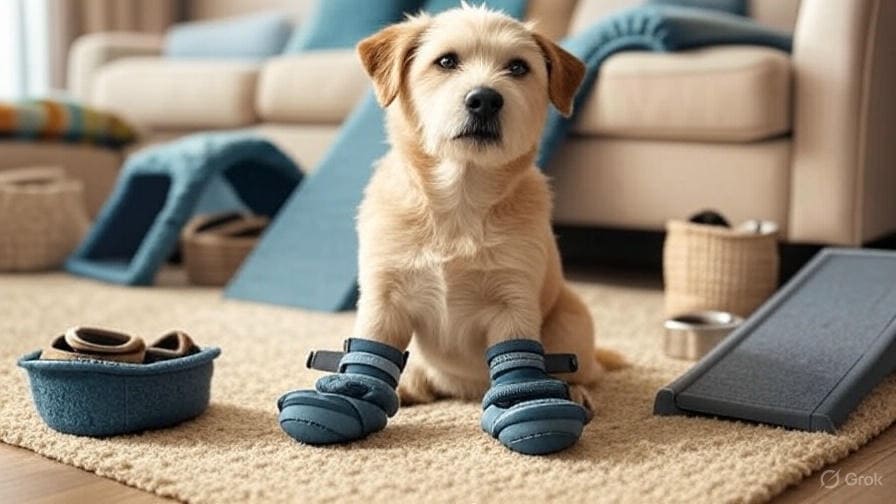Introduction
Arthritis is a prevalent condition in senior dogs, causing chronic joint inflammation, pain, and stiffness that hinder mobility and daily activities. For dogs with arthritis, walking on slippery or uneven surfaces can be painful and risky, increasing the chance of falls. Properly fitted dog shoes offer a practical solution, reducing joint impact, improving traction, and protecting paws.
This guide explores the benefits of arthritis-friendly shoes, key features to look for, and tips to help your dog adjust, ensuring safer, more comfortable walks. For complementary care, explore our guide on 8 tips to improve the quality of life for senior dogs.
Understanding Arthritis in Senior Dogs
Arthritis results from cartilage wear in joints, leading to bone-on-bone contact, inflammation, and pain, often affecting hips, knees, and elbows in senior dogs.
- Symptoms: Difficulty standing, limping, reluctance to climb stairs or jump, or reduced activity due to discomfort.
- Impact: Limited mobility increases fall risks, causes muscle loss, and lowers quality of life.
Dog shoes address these challenges by providing support and stability, encouraging gentle movement to maintain joint health. Veterinary guidance ensures shoes suit your dog’s specific needs, maximizing comfort and safety.
Benefits of Shoes for Dogs with Arthritis
Arthritis-friendly dog shoes are designed to enhance mobility and comfort, offering multiple advantages:
- Reduced Joint Impact: Padded soles absorb shock on hard surfaces like pavement, easing pressure on arthritic joints.
- Improved Traction: Non-slip soles provide grip on slick floors, reducing slips and boosting confidence.
- Enhanced Comfort and Safety: Protective shoes shield sensitive paws from injuries, extreme temperatures, or rough terrain, encouraging activity.
- Support for Muscle Strength: Stable footing promotes moderate movement, maintaining muscle tone around joints.
These benefits make shoes a valuable tool for arthritis management, complementing broader care strategies.
Key Features to Look for in Arthritis-Friendly Dog Shoes
Choosing the right shoes ensures comfort and functionality for your arthritic dog. Focus on these features:
- Proper Fit and Size: Measure your dog’s paws (length and width) and choose adjustable shoes with straps for a snug, non-irritating fit.
- Soft, Flexible Materials: Opt for lightweight, breathable fabrics like neoprene or mesh to allow natural movement and reduce joint pressure.
- Non-Slip Soles: Select rubber soles with textured grips for traction on indoor floors and outdoor terrain, minimizing fall risks.
- Easy to Put On and Take Off: Look for Velcro or zipper closures for stress-free dressing and a secure fit during walks.
- Example: Shoes with padded mesh uppers and grippy rubber soles balance comfort and stability for arthritic dogs.
These features ensure shoes support your dog’s mobility and well-being.
Recommended Types of Shoes
Different shoe types cater to specific arthritis-related needs, offering tailored support:
- Cushioned Sole Shoes: Feature padded soles to absorb shock, ideal for walks on hard surfaces like concrete. They reduce joint stress and enhance comfort.
- Non-Slip Rubber Boots: Provide superior grip for indoor and outdoor use, perfect for slippery tiles or wet grass, ensuring stability.
- Soft-Lined Models: Include fleece or padded linings to prevent friction, suitable for dogs with sensitive paws or extended wear.
- Example: A cushioned rubber boot with a fleece lining offers both traction and comfort for a dog with hip arthritis.
Choosing the right type depends on your dog’s environment and mobility challenges.
Tips to Help Your Dog Adjust to Wearing Shoes
Introducing shoes requires patience to ensure your dog feels comfortable and confident.
- Introduce Gradually: Start with 5–10-minute sessions indoors, increasing wear time over days to build familiarity.
- Make It Positive: Use treats, praise, or short play sessions while your dog wears shoes to create positive associations.
- Monitor Reactions: Watch for limping, paw licking, or attempts to remove shoes. Adjust fit or try a different model if discomfort occurs.
- Example: Reward your dog with a treat after a 5-minute walk in shoes to encourage acceptance.
These steps help your dog adapt, making shoes a seamless part of their routine. For additional mobility support, see our guide on hydrotherapy: a safe exercise for dogs.
Special Considerations When Using Dog Shoes
To maximize benefits and avoid issues, keep these considerations in mind:
- Don’t Overuse Shoes: Limit wear to walks or high-risk surfaces, allowing paws to breathe during rest to prevent irritation.
- Keep Shoes Clean: Rinse after walks to remove dirt or moisture, preventing infections or odors. Air-dry thoroughly.
- Watch for Discomfort: If your dog avoids movement or excessively licks paws, reassess fit or consult a vet to rule out pain.
- Example: Remove shoes after a 15-minute walk and check paws for redness to ensure comfort.
These precautions ensure shoes remain a safe, effective tool for arthritis management.
Alternatives to Dog Shoes for Mobility Support
If shoes aren’t suitable, other options can enhance mobility and safety:
- Non-Slip Rugs and Mats: Place rugs in high-traffic areas like hallways or kitchens to prevent slips on tile or hardwood.
- Dog Socks with Rubber Soles: Lightweight and breathable, these provide traction and are easier for some dogs to tolerate.
- Support Slings and Mobility Harnesses: Assist dogs with advanced arthritis during walks or stair climbing, reducing joint strain.
- Example: A grippy dog sock can stabilize indoor movement for a dog reluctant to wear boots.
These alternatives complement shoes, creating a supportive environment. For pain relief techniques, explore our guide on simple stretching exercises for senior dogs.
Veterinary Guidance
Consulting a veterinarian ensures shoes and alternatives align with your dog’s arthritis severity and health needs.
- Fit Assessment: A vet can recommend shoe types or sizes based on your dog’s condition.
- Mobility Evaluation: Regular check-ups monitor arthritis progression and adjust mobility aids as needed.
- Complementary Therapies: Vets may suggest hydrotherapy or supplements alongside shoes for holistic care.
- Example: A vet might recommend cushioned boots paired with glucosamine for a dog with moderate arthritis.
Veterinary input maximizes the effectiveness of mobility support, keeping your dog comfortable.
Frequently Asked Questions
How do I know if dog shoes fit properly?
Shoes should be snug but not tight, with no slipping or rubbing. Your dog should walk naturally without lifting paws excessively. Measure paws and check fit after short walks.
Can all arthritic dogs wear shoes?
Most can, but dogs with severe pain or skin sensitivities may need alternatives like socks. Consult a vet to confirm suitability.
How long should my dog wear shoes daily?
Use shoes for walks or high-risk activities (e.g., 15–30 minutes), removing them during rest to allow paw ventilation.
Conclusion
Choosing the right shoes for dogs with arthritis can transform their mobility and comfort, making walks safer and more enjoyable. By prioritizing proper fit, soft materials, non-slip soles, and easy closures, you can support your dog’s joint health and confidence. Introduce shoes gradually, monitor for comfort, and consider alternatives like rugs or harnesses if needed.
With veterinary guidance and thoughtful care, your senior dog can navigate their world with greater ease and happiness. Share your experiences with dog shoes in the comments!

